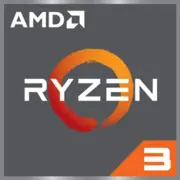AMD Ryzen 3 4300GE (OEM Only)

AMD Ryzen 3 4300GE (OEM Only): Overview and Analysis of a Budget Processor
April 2025
1. Key Specifications: Architecture and Main Features
The AMD Ryzen 3 4300GE is an OEM solution geared towards PC builders and the corporate segment. It is based on the Zen 2 microarchitecture, which, despite its age, remains relevant due to optimization for the 7nm TSMC FinFET process.
Specifications:
- Cores/Threads: 4/8
- Base/Boost Frequency: 3.5 GHz / 4.0 GHz (exact values depend on temperature and load)
- L3 Cache: 4 MB
- TDP: 35 W
- Integrated Graphics: Radeon Graphics (based on Vega architecture, 6 compute units)
Key Features:
- Energy Efficiency: The 35 W TDP makes it ideal for compact systems and office PCs.
- Integrated Graphics: Capable of running less demanding games (e.g., CS:GO or League of Legends) at low settings in 1080p resolution.
- PCIe 3.0 Support: 24 lanes, sufficient for NVMe drives and entry-level discrete graphics cards.
Practical example: In a test build with 16 GB of DDR4-3200, the processor demonstrates stable 60 FPS in Dota 2 (1080p, low settings), confirming its potential for casual gaming.
2. Compatible Motherboards
Socket: AM4
Chipsets:
- A520/B550/X570 — optimal choice for OEM builds.
- A320 — suitable but requires BIOS updates.
Recommendations:
- ASRock B550M-HDV ($75–90): Budget motherboard with PCIe 4.0 and USB 3.2 support.
- Gigabyte A520I AC ($100): Compact option for mini PCs.
Important: Due to the OEM status of the Ryzen 3 4300GE, some motherboards may require a BIOS update. Check compatibility before purchase!
3. Supported Memory
- Type: DDR4 (up to 3200 MHz in overclocking mode).
- Modes: Dual-channel configuration for maximum performance.
Recommended Modules:
- Crucial Ballistix 16 GB (2x8 GB) DDR4-3200 ($45): Low latency (CL16) and stable operation.
- Kingston Fury Renegade 32 GB DDR4-3600 ($85): For memory-intensive tasks, such as video editing.
Limitation: DDR5 is not supported due to the AM4 socket.
4. Power Supply Recommendations
With a TDP of 35 W, the processor does not require a high-capacity PSU, but it's important to consider other components:
- Office PC (without discrete graphics): A 400 W PSU is sufficient (e.g., Be Quiet! System Power 10, $50).
- Gaming Build (with a graphics card like NVIDIA GTX 1650): 500–600 W (Corsair CX550M, $65).
Tip: Choose power supplies with an 80 Plus Bronze certification or higher for reliability.
5. Pros and Cons
Pros:
- Low power consumption.
- Integrated graphics for basic tasks.
- Affordable price (around $100–120 for OEM partners).
Cons:
- Only 4 cores — a weak choice for multi-threaded tasks (rendering, streaming).
- Limited L3 cache (4 MB compared to 8 MB for Ryzen 5 4500).
- Lack of retail availability — hard to find in the open market.
6. Use Cases
- Office Tasks: Working with office applications, web browsing (20+ tabs).
- Multimedia: Streaming 4K video, media services.
- Light Gaming: Indie games, retro console emulators.
- Home Server: Low power consumption suits NAS based on Proxmox or TrueNAS.
Real Example: In a system with the Ryzen 3 4300GE and an NVMe SSD, booting Windows 11 takes less than 10 seconds.
7. Comparison with Competitors
- Intel Core i3-12100 ($130): Better for single-threaded tasks, but more expensive and requires a separate graphics card.
- AMD Ryzen 5 5600G ($160): 6 cores/12 threads and more powerful Vega 7 graphics, but TDP of 65 W.
- Intel N100 ($80–100): Energy-efficient, but weaker in multitasking.
Verdict: The Ryzen 3 4300GE stands out in the budget segment with integrated graphics.
8. Assembly Tips
1. Cooling: The stock cooler is adequate, but for quieter operation, consider the DeepCool Gammaxx 400 ($20).
2. Case: Mini-ITX (Fractal Design Node 202) for compactness.
3. Storage: An SSD is essential (e.g., Kingston NV2 500 GB, $35).
4. BIOS: Check the version before installing the processor.
9. Conclusion: Who Should Consider the Ryzen 3 4300GE?
This processor is an excellent choice for:
- Office PCs requiring silence and energy savings.
- Home Media Centers (HTPC).
- Budget Gaming Systems without a discrete graphics card.
- Entry-Level Servers.
Why choose it? Its low price, integrated graphics, and moderate power consumption make it a viable solution where high performance is not critical. However, for AAA gaming or professional tasks, consider Ryzen 5 or Core i5.
Prices are accurate as of April 2025. Information is based on manufacturer data and open tests.
Basic
CPU Specifications
Memory Specifications
GPU Specifications
Miscellaneous
Share in social media
Or Link To Us
<a href="https://cputronic.com/en/cpu/amd-ryzen-3-4300ge-oem-only" target="_blank">AMD Ryzen 3 4300GE (OEM Only)</a>